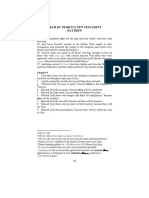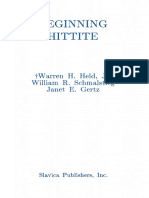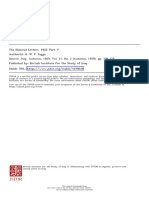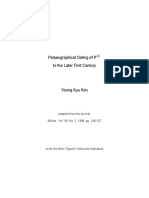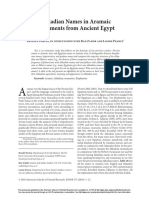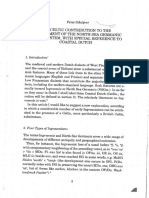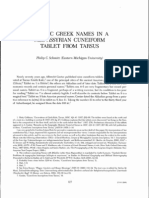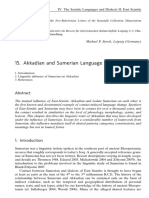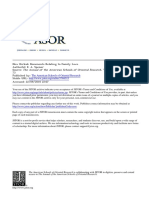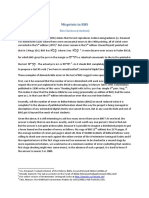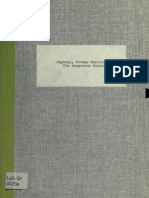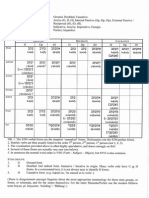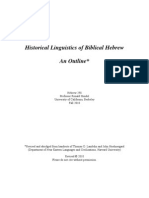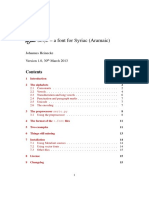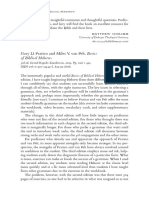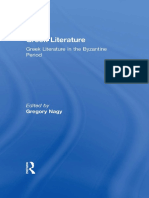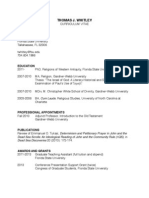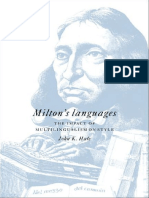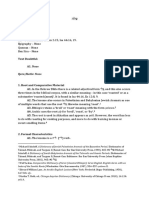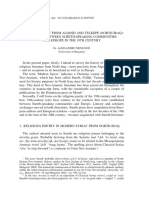Semitic Nominal Patterns
Comparative Semitic Grammar (SEM 709)
Primary vs. Motivated
• Primary: a noun that does not share a root with another word with a
similar meaning (Fox 1998; 2003: 61-87)
• e.g., ʾabn- ‘stone’, kalb- ‘dog’, ʾuðn- ‘ear’, etc.
• Only exist in the proto-language, since roots can be extracted in all of
the daughter languages, e.g., Syriac kallɔbɔ ‘dog-trainer’
• Can generally be reconstructed to PS
• Motivated: Pattern + Root = Noun
• e.g., *qaṭl- with √mlk gives NWS *malk- ‘king’
• Cannot generally be reconstructed to PS (but see SED 1.xlvii-xlviii
and especially Kogan 2008)
*qVṭl-
• normally substantives not adjectives
• in NWS plural base is qVṭal- with a-insertion, e.g., Hebrew *malak-īm
> mlɔḵim
• *qaṭl-
• most common, widest range of meaning, but almost always
substantives (especially action nouns)
• Akk. baqru ‘claim’, Arabic ḍarb- ‘striking’, Hebrew mɛ́lɛḵ ‘king’,
Syriac mlɛḵ, malkɔ
• Isolated nouns: ʾabn- ‘stone’, ʾarɬ̣- ‘earth’, kalb- ‘dog’, etc.
• *qiṭl-
• frequently passive or nouns of result
• Akk. šipru ‘message’, Arabic ʿilm- ‘science’, Hebrew zéḵɛr
‘memory’, Syriac ḥlɛm, ḥɛlmɔ ‘dream’
• Isolated nouns: *biʾr- ‘well’, *dimʿ-at- ‘tear’, etc.
� • *quṭl-
• often abstracts of stative roots
• Akk. dumqu ‘good thing’, Arabic ḥusn- ‘beauty’, Hebrew qóḏɛš
‘holiness’, Syr. quršɔ, qroš ‘coldness’
• Isolated nouns: *ʾuðn- ‘ear’, *ʾurx- ‘way’, *ḥupn- ‘hollow of hand’,
etc.
*qVṭVl-
• tend to be adjectives but there are substantives
• largely replaced in West Semitic by qVṭV̄l, due to the underlying
ambiguity of the feminine form qVṭV(:)l-t-
• *qaṭal-
• adjectives, mostly statives, e.g., Akk. rapšu ‘wide’, Arabic ḥasan-
‘handsome’, Hebrew ḥɔḵɔm ‘wise’
• some action nouns, e.g., Arabic ʿamal- ‘working’ (maṣdar), Gǝʿǝz
qabar ‘burial’
• base for suffix-conjugation in WS
• Isolated nouns: *ʾaθar- ‘place’, *ʿapar- ‘dust’, *ðahab- ‘gold’, *xatan-
‘son-in-law; bridegroom’, etc.
• *qaṭil-
• patiens actant nouns (especially adjectives), e.g., Akk. nakiru
‘hostile’, Arabic ḥazin- ‘sad’, Hebrew kɔḇeḏ ‘heavy’, Syriac damkɔ,
dmɛḵ ‘sleeping’
• Akkadian stative and WS suffix-conjugation with stative roots
• Isolated nouns: *katip- ‘shoulder’, *warik- ‘thigh’, etc.
• *qaṭul-
• Rare, some adjectives, e.g., Akk. marṣu- ‘sick’, Arabic ðakur-
‘remembering’, Hebrew gɔḏol ‘large’
• Also rare patterns of *quṭul- (Hebrew infinitive construct), *qiṭal-, and
*quṭal-
�qVṭV̄l-
• Primarily substantives in Akkadian, but adjectives in WS
• *qaṭāl-
• G infinitive in many languages, including Akkadian, Hebrew, and one
of the Arabic maṣdars
• In Gǝʿǝz, agent noun with *-ī, e.g., faṭāri ‘creator’, nagāśi ‘ruler’
• *qaṭīl-
• In Akkadian, substantives similar in meaning to *qaṭil-, e.g., zaqīpu
‘stake’
• In WS, patiens verbal adjective, e.g., Arabic ʿaẓīm- ‘much’, Gǝʿǝz
marir ‘bitter’, Hebrew nɔʿim ‘pleasant’, Syriac rḡiz ‘enraged’ (also
the G passive participle)
• *qaṭūl-
• Rare in Akkadian
• In WS, equivalent to PS *qaṭul, e.g., Arabic sakūt- ‘silent’, šakūr-
‘alcoholic’, Hebrew zɔḵur ‘remembered, mindful’
*qV̄ṭVl-
• Only the G active participle *qāṭil-
• Isolated nouns: *ʿālam- ‘world’, *ɣārib- ‘raven’
*qVṭṭV(:)l-
• *qaṭṭa(:)l
• Berufsname: actant noun, often denoting repeated or durative action;
in substantive form, member of a profession
• Akkadian has both *qaṭṭal- (see OA ša-ru-qú ‘thieves’ [nom.]) and
*qaṭṭāl- (see Assyrian na-pa-ḫi-im ‘smith’ [gen.])
• Arabic has qaṭṭāl, e.g., sajjād- ‘prostrated worshipper’ (many may be
Aramaic loans)
� • Aramaic has *qaṭṭāl-, e.g., Syriac gannɔḇɔ ‘thief’
• Hebrew forms are dayyɔn ‘judge’ but pl. con. dayyɔne ‘judges of’
• Other patterns (mostly rare) include *qaṭṭūl-, *qaṭṭil-, *qaṭṭīl-, *quṭṭul-,
*quṭṭūl-, etc.
Patterns with gemination of C3
• well-attested but difficult to identify because of orthographic limitations
in many languages
Reduplicated Patterns
• well-defined semantic groups, which are cross-linguistically common for
reduplication, such as diminutives, intensives, and sound-symbolic terms
• Substantives: *qVṭlV̄l- and *qaṭalṭV̄l-
• Adjectives: *qVṭlVl- and *qaṭalṭVl-
• Butts 2011
*taqṭi(:)l
• associated with the D-stem
M-preformative nouns
• place, e.g., Arabic mašrab- ‘drinking place’, Hebrew maʿmɔq ‘deep
place’
• instrument, e.g., Arabic miftāḥ- ‘key’, Hebrew mɛlqɔḥayim ‘tongs’
Suffixes
• -ān- individualizing morpheme, e.g., Akk. šarrāqānum ‘the thief in
question’
• Adjectival endings (nisba): *-īy- and *-āy-
• *-ūt- abstracts, e.g., *baʿlūt ‘lordship’












